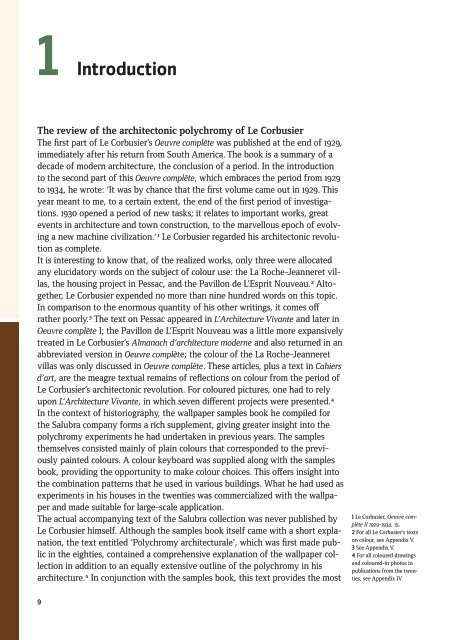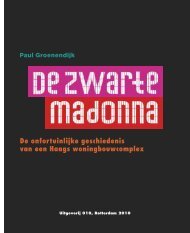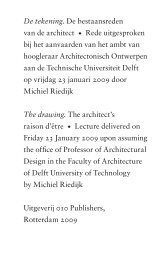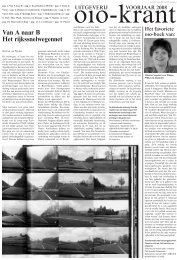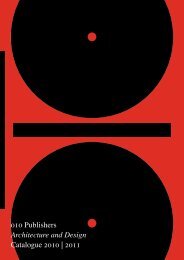The Architectonic Colour - 010 Publishers
The Architectonic Colour - 010 Publishers
The Architectonic Colour - 010 Publishers
Create successful ePaper yourself
Turn your PDF publications into a flip-book with our unique Google optimized e-Paper software.
1 Introduction<br />
<strong>The</strong> review of the architectonic polychromy of Le Corbusier<br />
<strong>The</strong> first part of Le Corbusier’s Oeuvre complète was published at the end of 1929,<br />
immediately after his return from South America. <strong>The</strong> book is a summary of a<br />
decade of modern architecture, the conclusion of a period. In the introduction<br />
to the second part of this Oeuvre complète, which embraces the period from 1929<br />
to 1934, he wrote: ‘It was by chance that the first volume came out in 1929. This<br />
year meant to me, to a certain extent, the end of the first period of investigations.<br />
1930 opened a period of new tasks; it relates to important works, great<br />
events in architecture and town construction, to the marvellous epoch of evolving<br />
a new machine civilization.’¹ Le Corbusier regarded his architectonic revolution<br />
as complete.<br />
It is interesting to know that, of the realized works, only three were allocated<br />
any elucidatory words on the subject of colour use: the La Roche-Jeanneret villas,<br />
the housing project in Pessac, and the Pavillon de L’Esprit Nouveau.² Altogether,<br />
Le Corbusier expended no more than nine hundred words on this topic.<br />
In comparison to the enormous quantity of his other writings, it comes off<br />
rather poorly.³ <strong>The</strong> text on Pessac appeared in L’Architecture Vivante and later in<br />
Oeuvre complète I; the Pavillon de L’Esprit Nouveau was a little more expansively<br />
treated in Le Corbusier’s Almanach d’architecture moderne and also returned in an<br />
abbreviated version in Oeuvre complète; the colour of the La Roche-Jeanneret<br />
villas was only discussed in Oeuvre complète. <strong>The</strong>se articles, plus a text in Cahiers<br />
d’art, are the meagre textual remains of reflections on colour from the period of<br />
Le Corbusier’s architectonic revolution. For coloured pictures, one had to rely<br />
upon L’Architecture Vivante, in which seven different projects were presented.⁴<br />
In the context of historiography, the wallpaper samples book he compiled for<br />
the Salubra company forms a rich supplement, giving greater insight into the<br />
polychromy experiments he had undertaken in previous years. <strong>The</strong> samples<br />
themselves consisted mainly of plain colours that corresponded to the previously<br />
painted colours. A colour keyboard was supplied along with the samples<br />
book, providing the opportunity to make colour choices. This offers insight into<br />
the combination patterns that he used in various buildings. What he had used as<br />
experiments in his houses in the twenties was commercialized with the wallpaper<br />
and made suitable for large-scale application.<br />
<strong>The</strong> actual accompanying text of the Salubra collection was never published by<br />
Le Corbusier himself. Although the samples book itself came with a short explanation,<br />
the text entitled ‘Polychromy architecturale’, which was first made public<br />
in the eighties, contained a comprehensive explanation of the wallpaper collection<br />
in addition to an equally extensive outline of the polychromy in his<br />
architecture.⁵ In conjunction with the samples book, this text provides the most<br />
9<br />
1 Le Corbusier, Oeuvre complète<br />
II 1929-1934, 15.<br />
2 For all Le Corbusier’s texts<br />
on colour, see Appendix V.<br />
3 See Appendix V.<br />
4 For all coloured drawings<br />
and coloured-in photos in<br />
publications from the twenties,<br />
see Appendix IV


